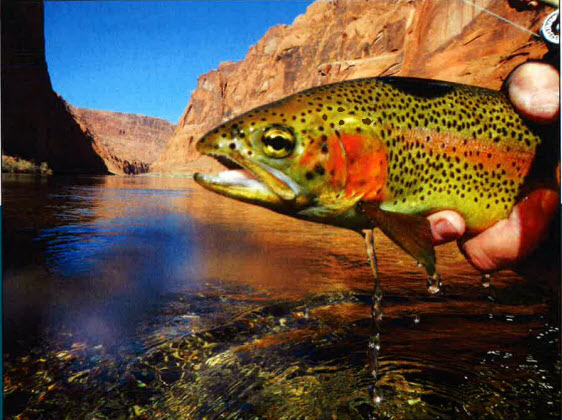Group Members
|
|
Chair: Vacant
Members: Shane Capron, Kurt Dongoske, Craig Ellsworth, Paul Harms, Brian Healy, Vineetha
Kartha, Ryan Mann, Jessica Neuwerth, Emily Omana Smith, Peggy Roefer, Seth Shanahan, Jim
Strogen.
Invited technical advisors: John Jordan, Scott VanderKooi, Mike Moran.
|
|
|
|
The TAHG met on three separate occasions (November 9th, December 7th and, January 14) to discuss the charge and provide comments on the GCMRC review of the Recommendations. Notes from these meetings are provided in appendix A. In the December 9, 2015 “Technical review of the Lees Ferry Recreational Trout Fishery Management Recommendations” memo to the TWG chair, GCMRC submitted an updated and final review in response to comments and suggestions received from the TWG regarding points of clarifications and topics that were not included in their initial review. This final review was limited to scientific and technical matters, and for recommendations where no scientific or technical information was presented, GCMRC limited their comments.
TAHG members were provided with comment forms and given one month to evaluate the GCMRC technical review of the Lees Ferry Recreational Trout Fishery Management Recommendations per the TWG charge. TAHG member comments are provided in appendix B.
There was uniform agreement by the TAHG membership that the GCMRC technical review is comprehensive. In addition, the TAHG respondents found GCMRC’s review either supported or was neutral / non-committal on thirteen of the fifteen individual recommendations. There was not uniform agreement on the GCMRC review conclusions on two of the recommendations:
- Minimum Flows and
- Stocking in the Event of a Catastrophic Fishery Failure. The TAHG concluded that while both Minimum Flows and Stocking are subjects for future discussion the Stocking issue is substantially determined by the provisions of the Park Service’s comprehensive Fishery Management Plan and the Arizona Game and Fish Department’s Fisheries Management Plan Colorado River – Lees Ferry (2015-2025).
|
Conclusions
|
- The TAHG review concluded that GCMRC review is generally comprehensive although it could be expanded in some areas.
- Additional discussion/clarification is needed by the TWG and GCMRC on the scientific basis of the minimum flow recommendation and the need for stocking in the event of a catastrophic failure of the Lees Ferry trout fishery
- The TWG should identify outstanding research questions that should be addressed to better inform any implementation of the Lees Ferry Recreational Trout Fishery Management Recommendations.
|
Recommendations
|
|
The TAHG recommends that the TWG recommend that the AMWG accept the GCMRC technical review of the Lees Ferry Trout Fishery Management Recommendations based on the TAHG evaluating the GCMRC technical review of the Recommendations and finding the review to be comprehensive and the review to be supportive, neutral or noncommittal on the individual recommendations with two exceptions. One exception being the Minimum Flow recommendation with agreement that research should continue to evaluate the effects of lower flows and to develop scientifically based minimum flows. The other exception being Stocking In the Event of a Catastrophic Failure and the impact on the dependent economic community be included in the determination for stocking and with the understanding that stocking is substantially determined by the provisions of the Park Service Comprehensive Fishery Management Plan and the Arizona Game and Fish Department’s Fisheries Management Plan Colorado River – Lees Ferry (2015-2025).
In addition the TWG requests that the AMWG, with the acceptance of the Lees Ferry Recommendations, instruct the TWG to consider the requirements for any implementation of the Recommendations including additional research that should be included in the work plan.
|
Information Needs
|
|
Through the TAHG discussions, additional items were captured that need further consideration as it relates to the Recommendations. Based on discussions at the TWG, it was brought up by a number of stakeholders that sideboards are needed for an evaluation of the Recommendations.. An initial list was developed but should be vetted by all stakeholders.
- Any actions resulting from the Recommendations must be fully consistent with the ‘Law of the River’ and DOI policy considerations.
- Recommendations that fall under the purview of water and natural resource management agencies such as Bureau of Reclamation, National Park Service, United States Fish and Wildlife Service and Arizona Game and Fish Department will require additional evaluation with these management agencies for further consideration.
- Recommendations that address dam operations are expected to be considered and evaluated in the ongoing Long Term Experimental and Management Plan Environmental Impact Statement.
Additionally, several of the comments received from TAHG members identified information needs and could be considered during the next triannual work planning process. Those questions include:
- It would be helpful for GCMRC to present a comparison of the current macroinvertebrate assemblage with the historical assemblage using EPT and other metrics of biological condition.
- Is there data which indicates that the Lees Ferry reach invertebrate community is nutrient-limited and could be improved by stream fertilization?
- Is there data on the benefits or impacts of using spring HFEs to boost trout populations rather than allowing for an unmanaged trout response?
- Is there evidence available on whether TMFs are expected to have “collateral damage” (Fishery recommendation 5, paragraph 1) on the aquatic food base or native fish?
- The recommended action cites two unintended consequences from TMF’s including damage to the aquatic food base and native fish. It would be helpful for GCMRC to provide review of these two concerns.
- What volume of woody material would be needed to create a detectable or significant effect on trout populations or the aquatic foodbase?
- How far downstream of the dam does the DO zone typically extend? Do low DO releases threaten the majority of the trout population, or just the upper reaches of it?
|
|
|
